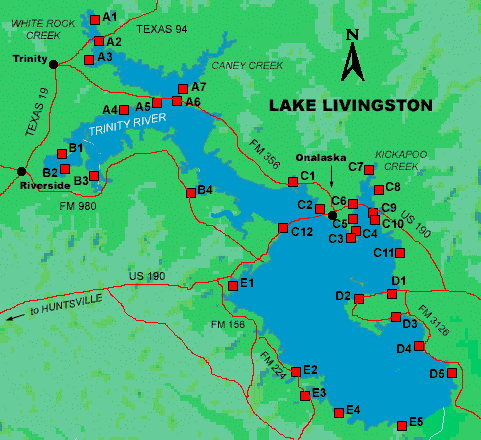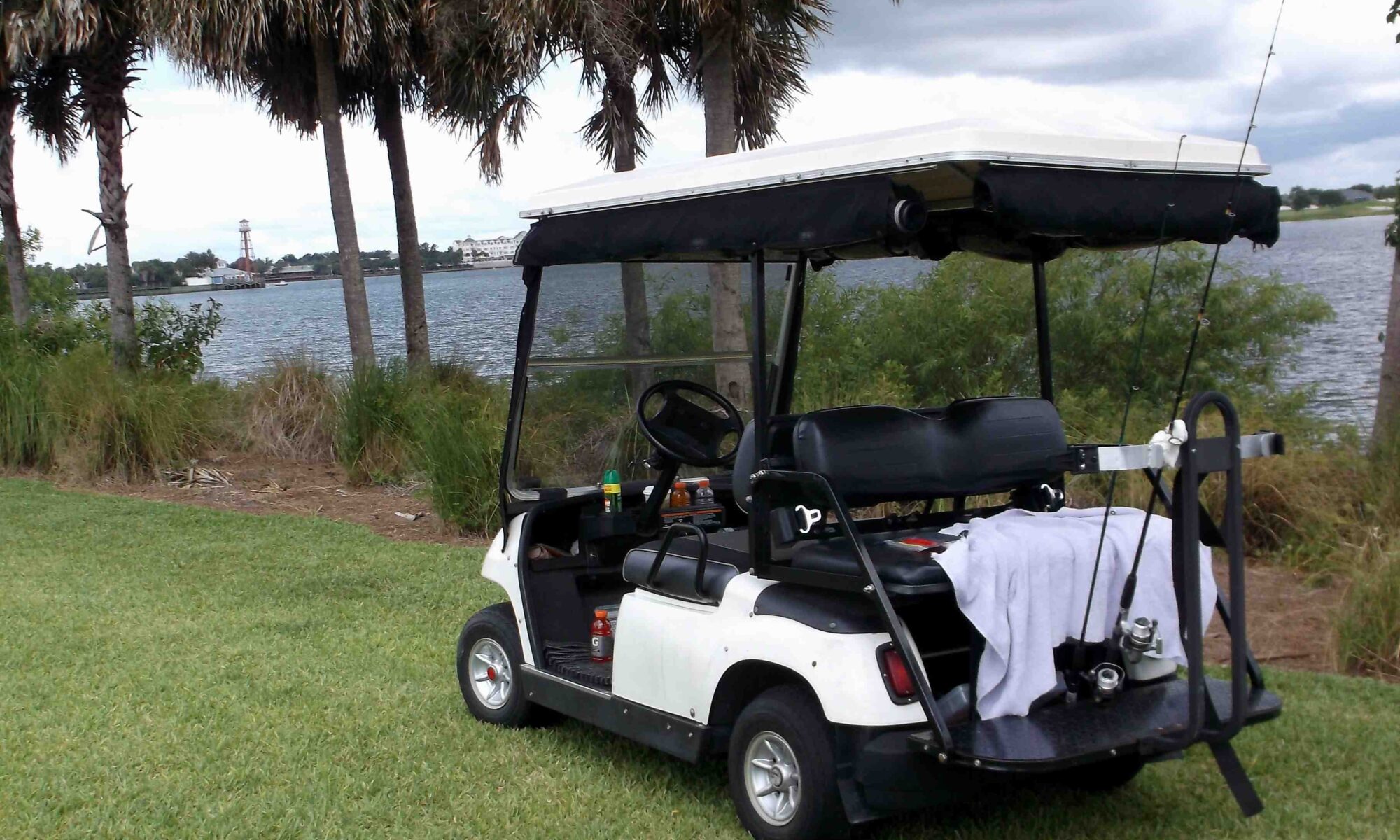Nestled in the Piney Woods region of East Texas, Lake Livingston stands as one of the state’s largest lakes and a premier fishing destination. Spanning across Polk, San Jacinto, Trinity, and Walker counties, this reservoir offers a vast playground for anglers of all skill levels. The lake is renowned not only for its size and beauty but also for the abundant and diverse fish populations that thrive in its waters. Additionally, the use of golf carts around the lake can significantly enhance your fishing experience, providing easy access to remote spots and a convenient way to transport gear.
Lake Characteristics

Location and Physical Characteristics:
- Surface Area: 90,000 acres, making it the second-largest lake entirely within Texas.
- Maximum Depth: Reaches up to 77 feet at its deepest points.
- Impounded: Constructed in 1969 for municipal and industrial water supply and recreational opportunities.
Water Conditions:
- Current Lake Level: Varies, but conservation pool elevation is typically around 131 ft. msl.
- Fluctuation: Experiences an annual fluctuation of 1-2 feet, largely depending on seasonal rainfall.
- Normal Clarity: Water clarity ranges from moderately to highly turbid, influenced by inflow and wind.
Aquatic Vegetation and Habitat

The aquatic environment of Lake Livingston is moderately vegetated, with native emergent plants primarily in the upper reaches of the reservoir and the backs of coves. Additionally, the invasive water hyacinth can be found throughout the lake. The presence of these plants plays a crucial role in providing habitat for fish and improving water quality.
Predominant Fish Species and Their Habitats
Lake Livingston offers a variety of angling opportunities with its rich population of fish species:
- Largemouth Bass
- Habitat: Prefer areas with abundant cover such as submerged structures and weed lines.
- Fishing Tips: Effective techniques include using spinnerbaits and plastic worms. Spring and fall are the best times to target these bass.
- Catfish (Blue, Channel & Flathead)
- Habitat: Found throughout the lake but are especially abundant in deeper river channel areas.
- Fishing Tips: Use baits like stink bait, shrimp, or chicken liver. Night fishing can be particularly productive.
- White Bass
- Habitat: Frequent the open waters of the lake but migrate upstream to tributaries during the spring spawning season.
- Fishing Tips: Effective lures include small spinners and jigs. Look for birds diving to locate feeding schools.
- Striped Bass
- Habitat: Prefer deeper waters, especially near the dam and main lake channels.
- Fishing Tips: Trolling with live shad or using spoons can yield good results.
- Crappie
- Habitat: Often found around bridge pilings, submerged timber, and brush piles.
- Fishing Tips: Use minnows or small jigs. Spring and late fall are the best times for crappie fishing when they move to shallower waters.
Angling Opportunities and Techniques

Maximize your fishing adventures at Lake Livingston by understanding the best practices for targeting the lake’s various species:
- Seasonal Fishing Tips:
- Spring: Target white bass during their spawning runs in creeks. Largemouth bass fishing is also excellent as fish are active.
- Summer: Focus on deeper waters for striped bass and catfish as they escape the heat.
- Fall: Good for all species as water temperatures cool and fish feed aggressively in preparation for winter.
- Winter: Ideal for crappie and some bass, using slower, more methodical techniques.
Golf Cart Utilization for Anglers
Using golf carts while fishing at Lake Livingston can transform your angling adventure, providing not just convenience but also expanding your access to the best fishing spots. Here’s a comprehensive overview of how golf carts can enhance your fishing experience, making it more productive and enjoyable.
1. Easy Transportation of Gear and Supplies
- Carry All Necessities: Golf carts allow you to load up all necessary fishing gear—rods, bait, coolers, and personal items—in one trip. This saves time and energy, especially when moving between multiple fishing locations.
- Special Modifications: Many golf carts can be customized with special features such as rod holders, tackle storage, and even built-in coolers, making them ideal for an organized fishing trip.
2. Access to Remote and Secluded Spots
- Reach Less-Accessible Areas: Some of the best fishing spots are off the beaten path, where vehicles cannot easily travel. Golf carts offer the capability to navigate rougher terrains to reach these secluded areas.
- Environmental Impact: With their quiet operation, golf carts are less likely to disturb wildlife or the natural setting, maintaining the peaceful environment that is crucial for a successful fishing trip.
3. Increased Fishing Time
- Quick Setup: The efficiency of moving quickly and smoothly from one spot to another with all your gear in tow means more time can be spent fishing rather than setting up.
- Flexibility in Fishing: Quick transportation allows for trying multiple locations in a single day. If one spot isn’t yielding results, it’s easy to move to another.
4. Comfort and Safety
- Enhanced Comfort: For those who find walking long distances challenging or have family members with mobility issues, golf carts offer a comfortable way to enjoy a full day of fishing.
- Safety Considerations: Carrying equipment on a golf cart reduces the risk of falls and injuries associated with hauling heavy gear, and provides a quick means of returning to safety in case of sudden bad weather.
5. Family and Group Fishing Adventures
- Family-Friendly: Golf carts make fishing more accessible for younger and older family members who may tire easily. The adventure becomes enjoyable for everyone with less fatigue and more fun.
- Group Coordination: When fishing in groups, golf carts facilitate better coordination and communication among members, ensuring everyone sticks together and enjoys the outing.
6. Support for Conservation Efforts
- Reduced Foot Traffic: By using golf carts, anglers can help minimize foot traffic in sensitive areas, reducing the impact on the lake’s natural habitats.
- Promoting Sustainable Practices: Golf carts can be equipped with trash and recycling compartments, encouraging anglers to dispose of waste properly and support conservation efforts.
Fishing Regulations and Conservation
When fishing at Lake Livingston, it’s essential to adhere to state and local fishing regulations to ensure sustainable practices are followed. These include:
- Bag and Size Limits: Specific limits are set for different species, which can vary by season.
- Fishing License: All anglers aged 17 and older must have a valid Texas fishing license, unless fishing within the boundaries of a state park.
Local Resources and Preparation
Before heading out to Lake Livingston for your fishing trip, consider these final tips and resources:
- Lake Maps: Utilize detailed lake maps available from local bait shops or online resources to identify key fishing spots and underwater structures.
- Preparation Tips: Pack appropriate gear for the weather, bring plenty of water and snacks, and ensure your golf cart is charged and ready for the day.
Conclusion
With its vast size, diverse fish populations, and beautiful natural settings, Lake Livingston offers a fantastic fishing experience for anglers of all levels. By incorporating a golf cart into your fishing adventures, you can explore this magnificent lake with greater ease and comfort, making your fishing trip not just successful but also enjoyable. Whether you’re a seasoned angler or a beginner, Lake Livingston has something to offer everyone.
Ready to experience the best of Lake Livingston fishing? Head over to Lake Livingston Golf Cars for all your golf cart needs to enhance your fishing adventure. Explore our selection and plan your next trip today!

